New Jag 980 arrives as contractor Jim Watt rues cashflow challenges
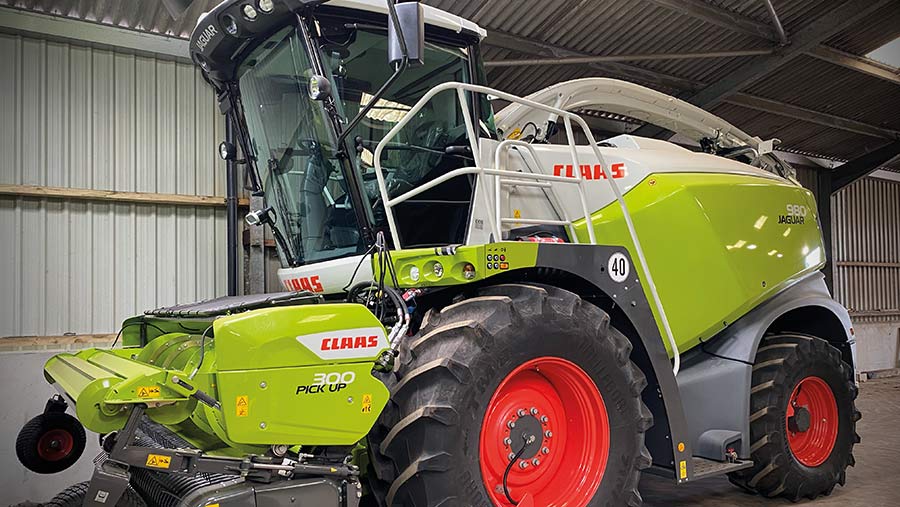 Claas Jaguar 98 © MAG/Oliver Mark
Claas Jaguar 98 © MAG/Oliver Mark Jim Watt of East Kilbride, South Lanarkshire runs a busy contracting firm focusing on baling and forage harvesting.
Cashflow is one of the biggest challenges facing his business as farmers’ margins tighten and prices become more volatile.
Despite the challenges though, if the weather plays along and work goes according to plan, he says there’s nothing better than seeing the kit out working.
We find out more about his business and his farm machinery.
See also: Remapped tractors boost performance for Cumbrian contractor
Business facts
Alexander Watt Contracting, Benthall Farm, East Kilbride
- Main services: Grass harvesting, slurry application, combining, drilling and cultivating, spraying
- Staff: Three full-time, up to nine during seasonal peaks
About the contractor

Jim Watt runs a 2,500ha silage, slurry and arable contracting business in East Kilbride
How did you get into contracting?
We started in 1985, which was a notoriously wet year. By October, we’d still not cut a blade of grass, the cows were due to come in and there were no contractors available to get the job done.
With that, we bought a trailed New Holland 717 forager to chop ours, and we ended up doing a neighbour’s, too.
Gradually, other local farmers stopped replacing their machines, and we continued to work on a relatively small scale until 1995, when a couple of contractors gave up.
Our first self-propelled came that year – everyone thought we were off our heads at the time – and we’ve continued to expand since.
We’re now at capacity and I don’t intend to take on any more work – summers come and go so fast that you can end up with zero time for yourself.
Main contracting enterprises?
Baling and forage harvesting. We chop up to 2,500ha of grass annually within a 40-mile radius of home, but the acreage varies depending on the size of the crop.
Last year was a big one and some customers had filled their second-cut clamps with first-cut forage.
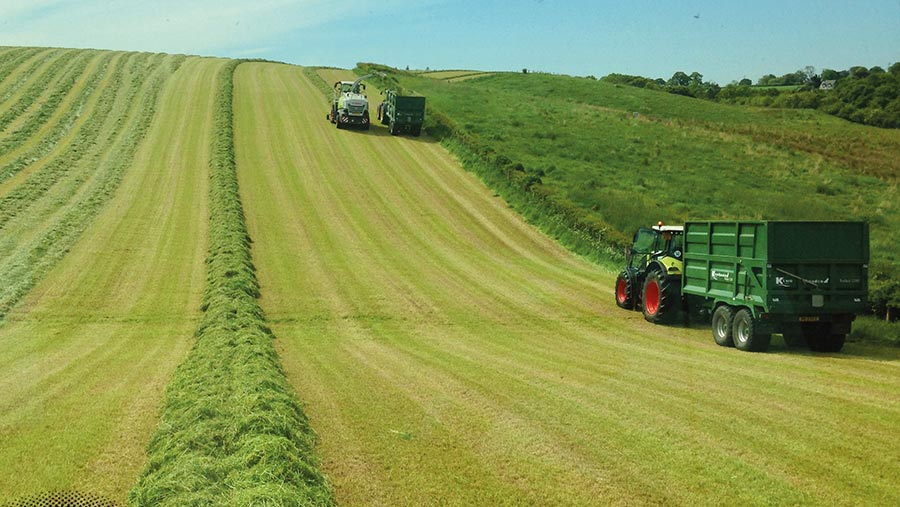
© Jim Watt
Then there’s 320ha of combining, plus spraying, cultivating, drilling and, in the winter, slurry application.
My dad always maintained that umbilical spreading was one of the best inventions ever.
There’s no mess in the gateways and we can get on the ground when it would be far too wet for a tanker.
The downside is that some customers are now buying their own systems with the help of grant money.
Kit list
- Tractors Fendt 724 x2, 720, 716, John Deere 6250R x2, 6155R
- Combines Claas Lexion 5500 with 25ft Convio header and Lexion 530 with 18ft Auto Contour
- Forager Claas Jaguar 980
- Balers McHale Fusion 4, Claas Quadrant 5500 big baler and McHale 998 square bale wrapper
- Grass Claas Disco 9200 butterfly x2 and 3200 front x2, Liner 2900 two-rotor and 4800 four-rotor rakes, Volto 1300 tedders x2, Einbock Grass-Manager harrow, Dalbo Maxiroll 630 flat rolls
- Slurry Slurrykat dribble bar and reelers, front-mounted compressor
- Handlers JCB 419S x2, TM320
- Sprayers and spreaders Knight 3,500-litre, 24m self-propelled, Kuhn Axis 40.2, Bunning Lowlander 105 x2
- Cultivators and drills Lemken Solitair 9+ 3m, Kverneland four-furrow ED85, Lemken power harrow 3m, Erth Panbuster 3m, Dalbo Levelflex 2800 press, Dalbo Maxiroll 630 Cambridge rolls
- Main other kit Ktwo Roadeo 12t trailers x5, Iveco gritter lorry, BvL V-Mix 17-2S diet feeder, McConnel PA53E hedgecutter
Any forms of diversification?
None now, but I used to be into gritting in a big way. At one point, I was the only “idiot” at it in this area, and the work I had on private sites was seriously profitable.
I spent £16,000 on a lorry and, in some years, it could bring in as much as a forager. I’d often go out in my slippers and not leave the cab all night.
However, other people eventually tap into these niches, and they become more competitive and less profitable.
I’ve packed it in and left it to the landscapers, who tend to look after the sites in the summer and then want the gritting job to keep their staff busy in the winter – usually with a SnowEx in the back of a pickup.
But a heavy dump of snow sorts the men from the boys, and usually they can’t cope.
Most and least profitable enterprises?
Tedding is good for us, as we can cover a lot of acres in a short period.
We used to run a 15m Lely but, when Agco took them on, sourcing spares became a problem and we switched to Claas Voltos – primarily because of the service.
They’re generally cheap to run, although we did wreck one on a bit of rough ground last year.
The 6.3m Dalbo Maxiroll flat roll has also comfortably paid for itself. We often rent it out and farmers love it, as they can do in a day what would usually take a week.
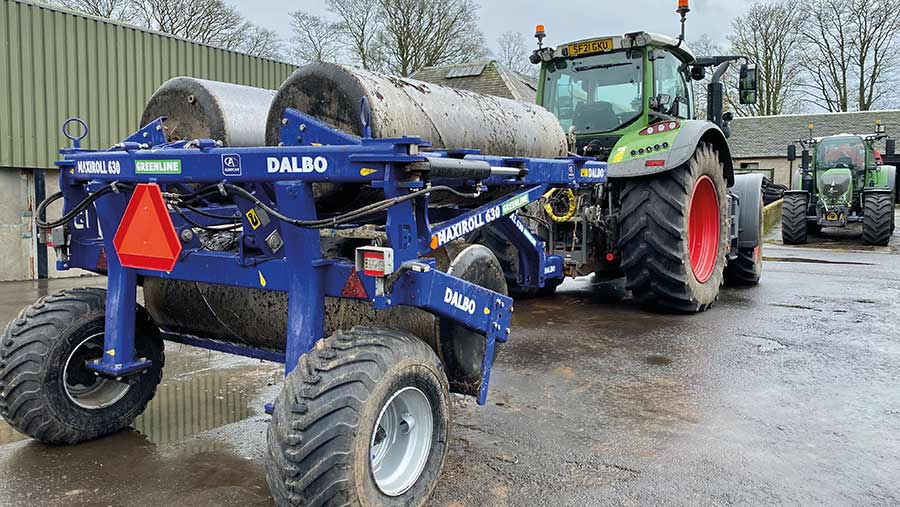
© MAG/Oliver Mark
Combining is the least profitable. We’re in the wrong area for it and I’ve thought several times about chucking it in, but it’s a service I feel I have to offer to avoid other contractors getting a foot in the door.
I also enjoy it – compared with silaging, with 10 men buzzing around at 100mph, all I have to worry about is getting my own backside on the seat.
Part of the problem is that the kit isn’t cheap and we have to be over capacity to manage the tight weather windows.
We’ve flitted between running one and two machines, but the second gives us the flexibility to keep customers relatively happy when the weather is against us.
Other necessary evils are slurry spreading and hedgecutting, which ensure I can retain the men over winter.
Although it’s expensive running relatively new tractors on these jobs, hiring them in wouldn’t be much cheaper than the hire-purchase agreements we have, and at least we have an asset at the end of it.
Biggest threats to your business?
Cashflow. It’s becoming more of a problem as customers’ margins get tighter, and the volatility of commodity markets always has a knock-on effect on how we’re paid.
Farmers shouldn’t have to rely on grants to stay in business; they should just get a fair price for what they produce, and they’re certainly not asking for a king’s ransom.
It’s the only industry where producers get told what they’re getting paid by the buyer, even if it’s below the cost of production, which I find very unfair.
When I first started, I could fire out the invoices for first-cut silage and expect to have the money soon after.
For that reason, we’ve always tailored our finance packages to suit, with smaller payments in the winter and bigger chunks during the harvesting season.
But with the cost of inputs rising, customers are under more strain and the money is slower to arrive, which makes it more difficult to time the outgoings.
The prices we charge haven’t come close to keeping up with the cost of machinery.
A 10t Fraser trailer was £3,000 in the 1990s, but our latest Ktwo Roadeos were £30,000.
And the new forager was the best part of £480,000, compared with our first self-propelled Jag 820 at £86,000 – and that seemed insane at the time.
Granted, it can cover 120ha in a day rather than 50ha, but something needs to change.
Difficulties with staff recruitment?
There was once a pool of men around here milking 100 cows or thereabouts.
But their businesses have either got bigger or shrunk to the point that they have sought other employment, which means there are fewer operators to call on.
We’ve currently got two other full-timers and up to nine during harvest, but some of them travel a long way. One chap now comes down from Fife.
My mentality has changed, too. I used to be prepared to work through the night to get the job done, but the older I get, the less inclined I am to do that.
I feel as if I missed a lot of time with my kids, summers went by in a flash, and I never had a chance to chill out and enjoy them. Farm contracting is a young man’s game.
What excites you about the season ahead?
If the weather is with us, and everything goes according to plan, then there’s nothing better than seeing the kit out working.
We’ve still got the capacity to hammer it quickly and get it over and done with if conditions are catchy, but it will inevitably end up with me pulling out what hair I have left.
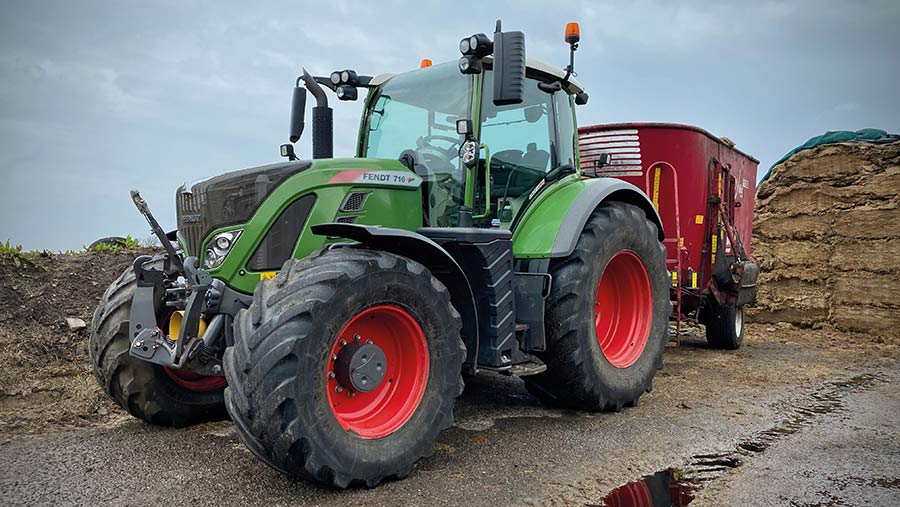
Fendt 716 © MAG/Oliver Mark
New machines in 2023?
A new Jaguar 980 arrived a couple of months ago. We decided to drop from two foragers – a 970 and 840 – to one, as the second machine was an expensive luxury that was lucky to do 400ha/year.
As usual, I’ve taken it on a four-year finance plan to make the payments manageable, but I try to change the machines every two years if Claas can keep the cost the same.
That is often the case, as the machines are as good as new and always dealer serviced.
I prefer this approach, as by supporting the dealers we tend to get preferential treatment should there be a breakdown or a warranty problem.
The way I see it, you cough up for either set payments or repairs, depending on which approach you take.
I prefer a hassle-free life – it only takes one engine blow-up to obliterate your profit.
The last forager stayed for three years because the long lead times meant I couldn’t get one with the spec I wanted.
Claas was willing to stick with the agreed payments for a replacement 970 and said it would honour the price of the trade-in.
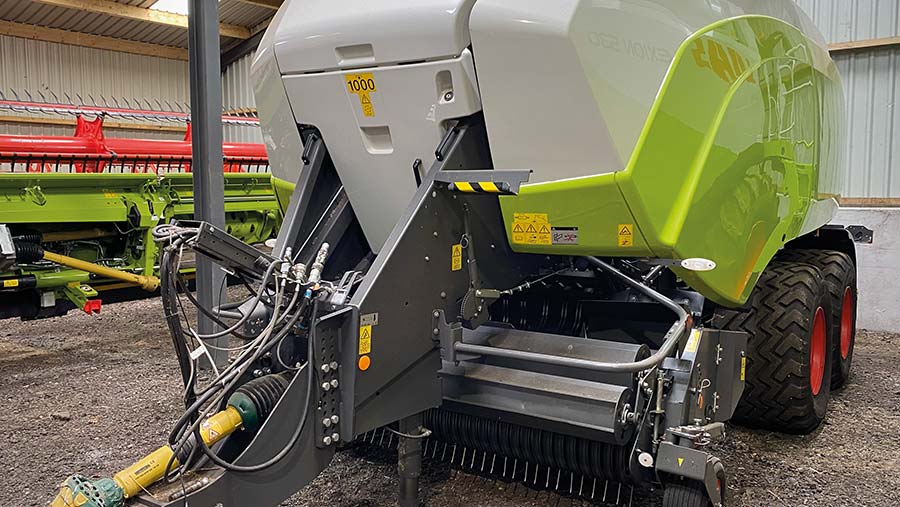
Claas Quadrant © MAG/Oliver Mark
But then they couldn’t get me a 2022-built slot. It would have been no problem – I didn’t need it until harvest this year – except there was a looming end-of-year price rise, which was going to cost us an extra 15%.
Fortunately, Claas Germany had a 980 on the build line with no one’s name on it.
It cost £20,000 more than the deal I had agreed, but I jumped at it, as it was far cheaper than a 2023-built 970 and gives us more capacity than we need.
It’s well specced – I’ve got the twin-header drive, central tyre inflation and pretty much everything else, except a Quantimeter yield monitor.
I can’t make the cost of that stack up.
Also on its way is a McHale Fusion 4, which will replace a pair of Fusion 3s that had done three seasons.
The main reason for dropping to one machine is that we’ve now got the Quadrant 5500 big baler and a McHale 998 square bale wrapper that together are doing about one-third of the work.
Demand for squares is growing as we can stuff more grass in a bale and they make for a tidier stack.
For the customers, it costs about the same per tonne of forage.
But the beauty of the Fusion is that it’s a one-man job.
More customers are asking for film-on-film wrapping, which only one of the old models was geared up to do, and the Fusion 4 is supposed to have improved a lot.
The pick-up should be far better and we’ve gone to a 1,000rpm drive that is said to make a tremendous difference.
It has on-board weighing and moisture reading, too.
These are for us rather than the customers – the film-on-film system can be quite cantankerous, so that extra information should help get the settings bang-on.
I’ve also bought a second-hand JCB TM320 on 2,500 hours.
It’s coming from a customer who is very particular about maintenance, so it’s in decent condition, and will replace an old Claas Scorpion for moving bales and feeding the bed-and-breakfast cattle over the winter.
For the clamp, and for loading the muckspreaders, we have two JCB 419Ss. Watching them work is like poetry in motion and there’s no chance of a single 435 keeping up.
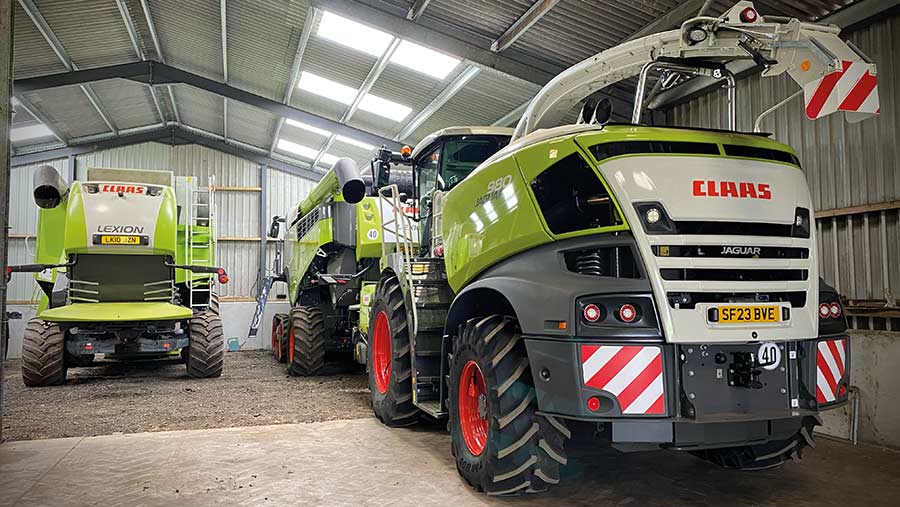
Claas Jaguar Lexion © MAG/Oliver Mark
Recent major repairs/breakdowns?
The chopper ended up in a ditch last year and, when the £16,000 bill for a load of new panels came through, I thought I’d accidentally ordered a new machine.
Overwinter projects?
Next year, we’re going to knock up a roller and wrap carrier to go on the front of the baler tractor.
Other than that, it’ll just be hedgecutting and slurry spreading.
Despite what the “experts” say, I’m convinced that grass crops given a dose of slurry between November and January take the nutrients in and green up far quicker.
I also question the merit of nitrate vulnerable zones. Surely being able to apply little and often reduces the risk of run-off compared with rushing to apply a big dose when you’re allowed to – then risking it going into a ditch when we have a spell of rain.
Current contractor frustrations?
I’ve decided to rewrite a book of memoirs, which I’ve titled Do you know it’s to rain tomorrow?.
The weather is my biggest gripe in life and, like Graham Hayllar in last month’s Contractor Comment, I’ve found that smartphone apps have made it 10 times worse.
Customers just flick through all the apps they have until they find a forecast that suits them.
The days of basing a week’s work on the Countryfile weather forecast are long gone.
The second chapter of the book is called “I don’t know what happened – it was like that when I got it”, followed by “I canna make it tomorrow – I’m going to the Highland Show”.
And my other gripe is with farmers doing their own tedding.
They should be licensed and have to sit a test every year to make sure they’re competent, because most of them race through it at 100mph and leave us a tangled mess to pick up.
Life as a contractor isn’t without its stresses.

